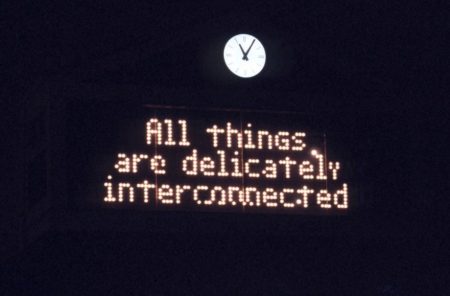
There are / were a lot of holidays effected by COVID-19 measures this spring; Ramadan, Passover, and Easter to name the heavyweights. For me what stood with a heavier weight than normal was Earth Day. Every year on April 22, we celebrate the beginning of what is now known as the official beginning of the Environmental movement that got placed in concrete on that date in the year 1970. It was just months after that fateful declaration was made that the Environmental Protection Agency was born and revolutionary laws such as the National Environmental Education Act, the Occupational Safety and Health Act, and the Clean Air Act were passed.
For Earth Day 2020 Hauser & Wirth, in collaboration with Jenny Holzer, is releasing A Limited-Edition Benefit Print that features one of the artist’s iconic ‘Truisms,’ ALL THINGS ARE DELICATELY INTERCONNECTED (1977-79), relaying a timely message that speaks to the global health and environmental crises we are navigating today. The project is part of Hauser & Wirth’s #artforbetter initiative through which the gallery will provide charitable support in response to both global and local causes. To acknowledge the 50th Anniversary of Earth Day as well as provide honor to the current situation in which many of us are isolated, purportedly all of their sales proceeds will go to charitable partners. This donation will be split equally between the conservation initiative Art for Acres and the COVID-19 Solidarity Response Fund for the World Health Organization.
I’ve noticed that in this time of forced dichotomous work or monastic solitude, it appears that we as a collective society have fallen back on the things that have always nurtured: the outdoors and the arts. I won’t discuss our dependence on the arts because I’ve read it to death and I’m sure you have as well. But I’d like to consider our earthly dependence. Whether it be newfound family walks, the opportunity to engage in outdoor athletic activity at a higher rate than is typically normal, or a sudden interest in gardening / composting / fermenting practices, the public has reengaged with the outdoors in a way that heals. Perhaps hopefully this time is an opportunity to assess how important those exterior spaces are, and how important it is to engage with them in a way that isn’t opportunistic and for fiscal benefit—perhaps, it can even be considered with regard to mutual benefit. How can we aid in bacterial, faunal, and biomatter improvement.
Reading of Holzer’s collaboration and viewing this older work imaged above—pointing to the ‘truism’ that all things are interconnected— I can’t help but think of the weight that has been temporarily lifted off of the planets’ shoulders by our forced economic break. Of course it’s naive to believe that capitalism won’t fight its way back to a returned normal, but hopefully this is our reminder that in our immense loss (heartbreaking death tolls, time with family and friends lost, economic and career opportunities down the drain) we take solace in the equilibrium. In our stopping the planet could breathe for a moment. I also found Holzer’s message to be particularly revelatory in light of the other work I’d like to mention—that successfully renders our very real interconnectedness in all of the ways that we are: biologically, neoliberally, culturally, and with regard to the joy of creation and the celebration of renewal.

On April 22nd, also in honor of Earth Day and their #cultureisnotcancelled campaign, AnOther published an interview with Wanda Orme on her new work Akasha. The sculptural work that was intended to be shown at the now-cancelled Bombay Beach Biennale has found its home in the sea. But after hearing of the Biennale’s cancellation, Orme spoke of taking the conceptualization that she had in London about five months ago and returning to the Salton Sea, a dying sea located within the San Andeas Fault in California, where she would build the work and install it in isolation. The sculpture, a towering, 20ft-high structure constructed from wire wrapped in fiberglass and resin, is installed in a very shallow body of water. The piece recalls huge tentacles calmly erupting from the earth and peering to the world that surrounds it. A surreal, half dead, but absolutely breathtaking stretch of void / non void.
Orme goes on to explain that “Akasha translates loosely to mean sky, all pervasive substance or aether — for me it is a way to reference the animating substance or energy that courses through all life.” Take what you will of Orme’s sentiments about ever flowing energy, but there is an obvious duality to our experience of this particular historic moment. Where there is pressure to stop, there is a release. And it feels as if this moment relays us the opportunity to assess and take advantage of the time to observe actions that we have been forced into (i.e the slow down of production, lessening our reliance on fossil fuels, altering how we travel to name a few). The artist goes on to elaborate that this work “calls to the waters that connect all life, Akasha is a symbol of hope and continuity — things slip through the cracks, life finds a way and through this unusual genesis new ideas are born. Where there is water there is life. This is about hope in a ‘hopeless’ place. At the shore of a dying sea, what can be done? . . . Here it can be so quiet and still that when a flock of birds fly overhead you can hear the rushing of their wings. Away from the noise of modernity there is another sound, the hum of creation (and decreation) – life in process, nothing is static.
In this time of fear, loss, gratitude, calm, anxiety, panic, joy, planning for the future and reprioritizing—both Holzers’ and Ormes’ sentiments ring true.
–Megan Bickel